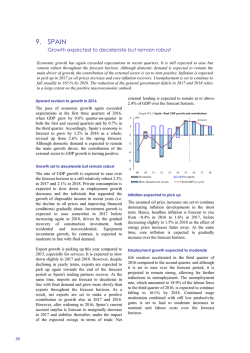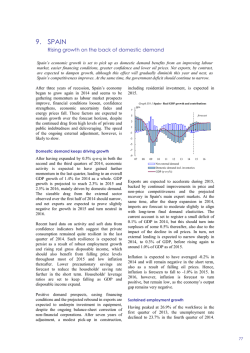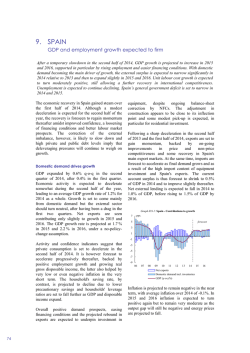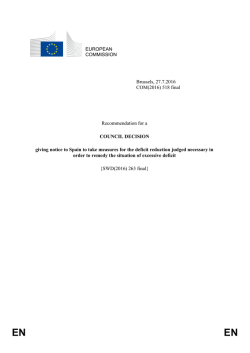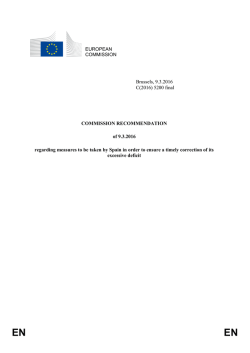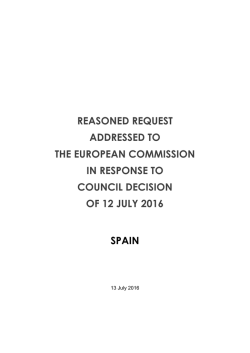
European Economic Forecast Spring 2016
9. SPAIN Growth to ease but remain robust Economic growth is set to continue easing but to remain robust, underpinned by sustained job creation and declining unemployment, improved financing conditions and low oil prices. Inflation is expected to remain negative in the short term due to falling energy prices. The general government deficit is expected to narrow, mainly thanks to the economic recovery. Robust expansion set to continue Economic growth remained robust in the fourth quarter of 2015 at 0.8% quarter-on-quarter, which led the economy to expand by 3.2% in the year as a whole, driven by domestic demand. GDP growth in the first quarter of 2016 was likely slightly slower at around 0.7%. Growth appears to be losing some momentum as reflected by the Economic Sentiment Indicator (ESI) but it is set to maintain a robust pace over the forecast horizon on the back of positive labour market developments, improved access to credit for firms and households, and low oil prices. The drag on domestic demand from private sector deleveraging is expected to fade out. Accordingly, Spain’s economy is forecast to grow by 2.6% and 2.5% in 2016 and 2017, respectively. negative for growth in 2016, before turning broadly neutral in 2017. The current account surplus is forecast to widen slightly further to 1.5% of GDP in 2016 and to narrow thereafter, to 1.3% of GDP in 2017, due to the deterioration of the terms of trade. Net external lending is expected to remain above 2% of GDP throughout the forecast horizon. 2.0 Graph II.9.1: Spain - GDP growth and Economic Sentiment Indicator (ESI) q-o-q% balance 120 115 1.5 110 1.0 105 0.5 100 0.0 95 -0.5 90 85 -1.0 Although private consumption is expected to decelerate throughout 2016, it is set to remain the main growth driver over the forecast horizon, supported by low inflation and steadily improving labour market conditions. The increase in gross disposable income is expected to allow households to increase their savings rate in 2016 and 2017, albeit only slightly. Although displaying a decelerating profile over the year, equipment investment is also forecast to maintain healthy growth rates over the forecast horizon, underpinned by positive demand prospects, supportive financing conditions and a projected rebound in exports in 2017. Construction investment is forecast to lose momentum in 2016 but to accelerate in 2017. The expected deceleration in 2016 would be explained by nonresidential construction, especially public investment. Residential investment looks set to gather strength steadily. Export growth is expected to slow down in 2016, especially for goods, due to the projected weakening of Spain’s main export markets. While imports are forecast to decelerate in line with final demand, they are expected to continue to outpace exports. As a result, net exports are set to prove 82 80 -1.5 75 -2.0 70 07 08 09 10 11 12 Real GDP (lhs) 13 14 15 16 ESI (rhs) The fall in oil and energy prices are expected to keep dominating inflation developments in the short term. Hence, headline inflation is forecast at −0.1% in 2016, whereas core inflation is expected to remain positive though moderate over the forecast horizon, due to low external price pressures and remaining slack in the economy. In 2017, headline inflation is forecast to return to positive territory. Employment growth keeps moderating Job creation decelerated moderately in the first quarter of 2016. While this trend is expected to continue over the forecast period, employment is still projected to record high growth rates, above 2% over the forecast horizon. Despite expected moderate wage dynamics, unit labour costs are forecast to increase on the back of low productivity increases. In turn, the unemployment rate, which amounted to 20.9% of the labour force in the last Member States, Spain quarter of 2015, is expected to continue falling to some 18% by 2017. The amount of fiscal policy measures needed to correct the budgetary slippage registered in 2015 add to the downside risks to the growth forecast stemming mainly from the uncertainty surrounding the formation of the new government. Deficit reduction driven by the recovery Driven by strong economic growth, Spain’s general government deficit continued to decline in 2015. The full-year deficit narrowed from 5.9% of GDP in 2014 to 5.1% in 2015. Despite cuts in personal income taxes, total tax revenues held up well, helped by a strong recovery in domestic demand and corporate tax revenues. Government expenditure picked up in the second half of the year, with notable increases in compensation of employees and public investment. About 0.3% of GDP of the full-year deficit stems from one-off factors that are not expected to spill over to 2016 (0.2 pps. due to a reclassification of assets of public-private-partnerships on the government’s balance sheet and 0.1 pps. due to support to the financial sector). Spain’s general government deficit is expected to narrow to 3.9% of GDP in 2016 and is projected to reach 3.1% of GDP in 2017. The reduction of the deficit relies to a large extent on the positive macroeconomic outlook, which is expected to continue supporting tax revenues and keeping social transfers in check. In particular, while pension expenditure is expected to continue rising, falling unemployment should reduce the growth of social transfers in the near future. Previous improvements in financing conditions and the decelerating public debt ratio imply that interest expenditure is likely to continue to fall. Finally, the forecast assumes savings of about 0.3% of GDP in 2016 from the recently announced measures aimed at reining in spending at central and regional government level. These savings, part of which is assumed to decrease expenditure also in 2017, are subject to implementation risks, as they require active involvement by different tiers of government and strict enforcement. After deteriorating significantly in 2015, Spain’s structural deficit is expected to increase further by around ¼ pps. over the forecast period, to 3¼% of GDP in 2017. Thanks to a narrowing deficit and relatively strong nominal GDP growth, the public debt ratio is expected to peak in 2016 at 100.3% of GDP before falling back to 99.6% in 2017. Table II.9.1: Main features of country forecast - SPAIN 2014 bn EUR GDP Private Consumption Public Consumption Gross fixed capital formation of which: equipment Exports (goods and services) Imports (goods and services) GNI (GDP deflator) Contribution to GDP growth: Annual percentage change Curr. prices % GDP 96-11 2012 2013 2014 2015 2016 2017 1041.2 100.0 2.6 -2.6 -1.7 1.4 3.2 2.6 2.5 606.8 58.3 2.3 -3.5 -3.1 1.2 3.1 3.0 2.3 202.4 19.4 3.9 -4.5 -2.8 0.0 2.7 1.0 1.0 204.1 19.6 2.5 -7.1 -2.5 3.5 6.4 4.7 5.0 66.6 6.4 3.9 -8.5 4.0 10.6 10.2 7.7 6.5 338.8 32.5 5.1 1.1 4.3 5.1 5.4 4.5 5.2 312.9 30.1 5.1 -6.2 -0.3 6.4 7.5 5.8 5.8 1036.9 99.6 2.5 -1.6 -1.4 1.4 3.6 2.6 2.5 2.7 -4.5 -2.8 1.3 3.6 2.9 2.6 0.0 -0.3 -0.2 0.2 0.1 0.0 0.0 -0.1 2.1 1.4 -0.2 -0.5 -0.3 -0.1 Domestic demand Inventories Net exports Employment Unemployment rate (a) Compensation of employees / f.t.e. Unit labour costs whole economy Real unit labour cost Saving rate of households (b) GDP deflator Harmonised index of consumer prices Terms of trade goods Trade balance (goods) (c) Current-account balance (c) Net lending (+) or borrowing (-) vis-a-vis ROW (c) General government balance (c) Cyclically-adjusted budget balance (d) Structural budget balance (d) General government gross debt (c) 1.7 -4.9 -3.5 1.1 3.0 2.5 2.0 13.8 24.8 26.1 24.5 22.1 20.0 18.1 3.3 -0.6 1.7 -0.6 0.5 0.8 1.0 2.5 -2.9 -0.2 -0.8 0.3 0.7 0.6 -0.3 -3.0 -0.8 -0.4 -0.3 -0.2 -0.8 10.6 8.8 10.0 9.6 9.4 9.5 9.6 2.8 0.0 0.6 -0.4 0.6 0.9 1.4 2.8 2.4 1.5 -0.2 -0.6 -0.1 1.4 -0.1 -1.1 0.9 -1.0 3.2 2.1 -0.2 -5.5 -2.8 -1.4 -2.2 -2.0 -1.9 -2.4 -4.6 -0.4 1.5 1.0 1.4 1.5 1.3 -3.9 0.1 2.2 1.6 2.1 2.3 2.1 -2.8 -10.4 -6.9 -5.9 -5.1 -3.9 -3.1 -3.0 -6.4 -2.4 -2.3 - -3.1 -3.1 -3.2 - -3.4 -2.0 -1.9 - -2.9 -3.1 -3.2 53.0 85.4 93.7 99.3 99.2 100.3 99.6 (a) as % of total labour force. (b) gross saving divided by gross disposable income. (c) as a % of GDP. (d) as a % of potential GDP. 83
© Copyright 2024
